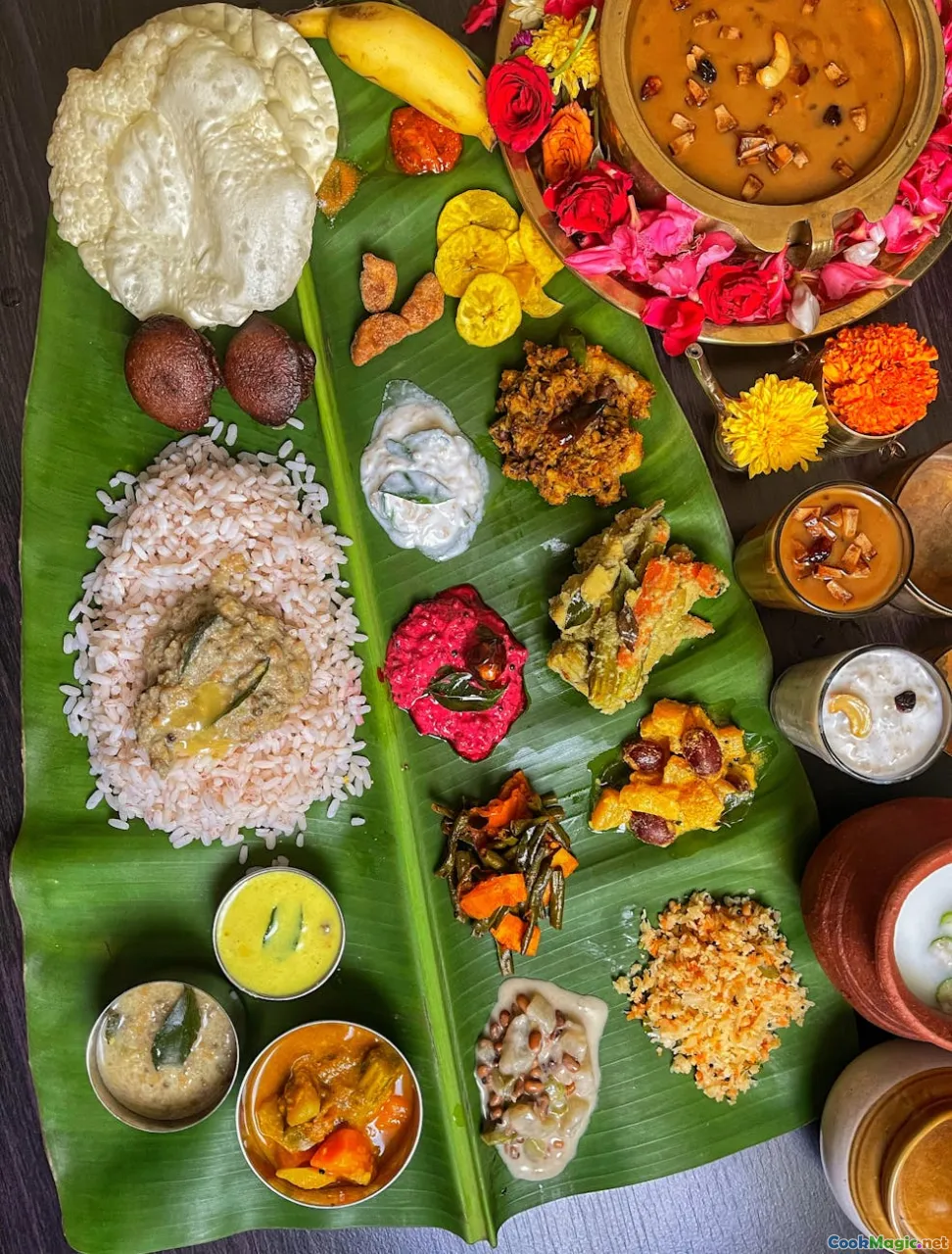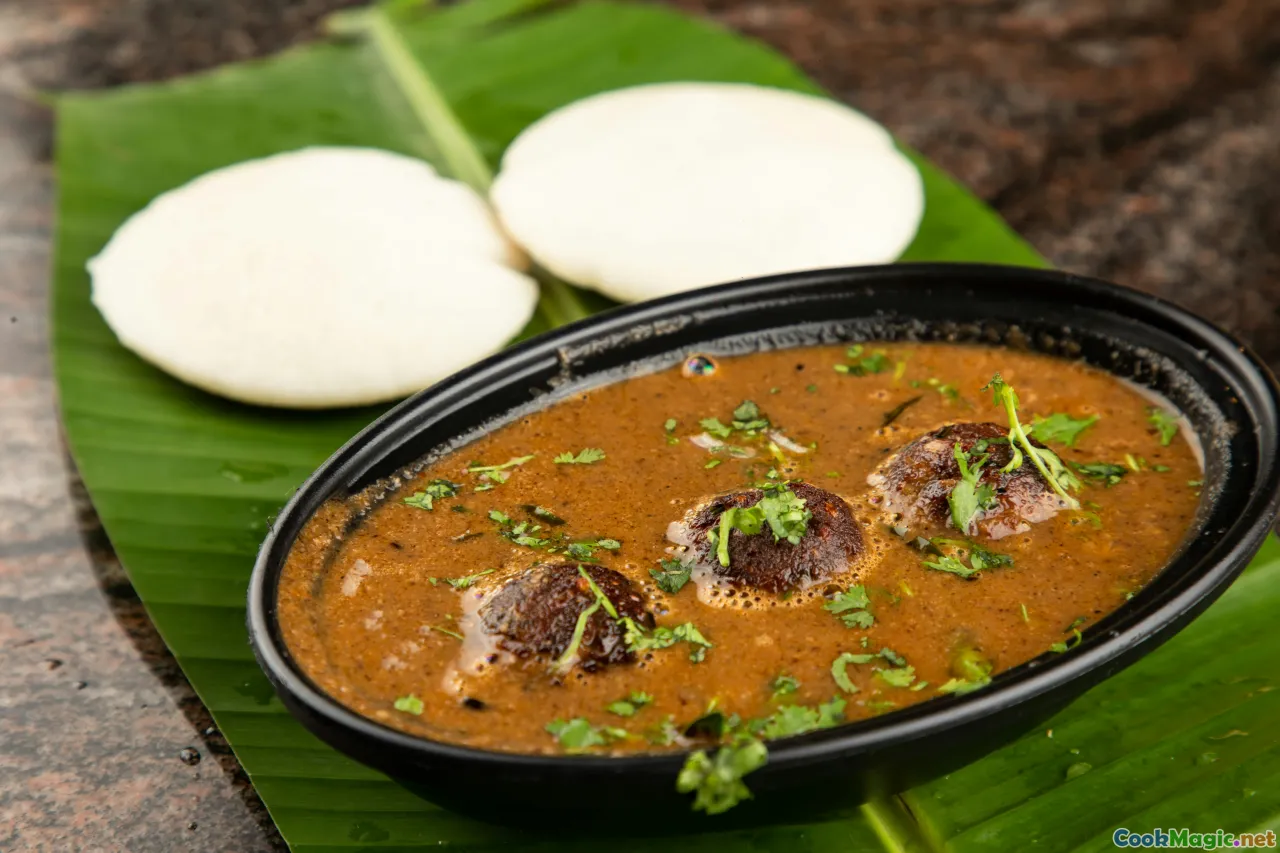
नागापट्टिनम पच्चाई मोचाई कूटू: तमिल शैली की बीन्स करी
(Nagapattinam Pachai Mochai Kootu: Tamil Style Bean Curry)
(0 समीक्षाएँ)सामग्री
-
250 grams ताजा क्षेत्रीय सेम (पाचाई मोज़ाइ)
(ताज़े या जमे हुए बीन्स का उपयोग करें; सूखे बीन्स को रात भर भिगोना चाहिए.)
-
50 grams कद्दूकस किया हुआ नारियल
(ताजी सामग्री प्रामाणिक स्वाद के लिए प्राथमिकता दी जाती है.)
-
2 tbsp चना दाल (टूटा हुआ बंगाल ग्राम)
(मोटाई और बनावट प्रदान करता है.)
-
1 tsp जीरे के बीज
-
2 pieces ताजा हरे मिर्च
(अपने मसाले की तीखापन के अनुसार समायोजित करें.)
-
0.5 tsp हल्दी पाउडर
-
1 medium प्याज
(बारीक काटा हुआ।)
-
1 medium टमाटर
(मोटे कटे हुए)
-
1 tsp नमक
(स्वाद के अनुसार समायोजित करें।)
-
500 ml पानी
(बीन्स और कूटू पकाने के लिए।)
-
2 tbsp तेल (अधिमानतः नारियल या सूरजमुखी)
-
1 tsp सरसों के बीज
(तड़का के लिए.)
-
1 tsp उड़द दाल (टूटा हुआ काला चना)
(तड़का के लिए.)
-
1 piece सूखा लाल मिर्च
(टूटा हुआ, टेम्परिंग के लिए.)
-
1 sprig करी पत्ते
(ताज़ा, तड़के के लिए.)
-
0.25 tsp हींग (Hing)
(चुटकी भर; स्वाद बढ़ाता है।)
-
2 tbsp ताजा धनिया के पत्ते
(बारीक कटा हुआ; सजाने के लिए.)
(ताज़े या जमे हुए बीन्स का उपयोग करें; सूखे बीन्स को रात भर भिगोना चाहिए.)
(ताजी सामग्री प्रामाणिक स्वाद के लिए प्राथमिकता दी जाती है.)
(मोटाई और बनावट प्रदान करता है.)
(अपने मसाले की तीखापन के अनुसार समायोजित करें.)
(बारीक काटा हुआ।)
(मोटे कटे हुए)
(स्वाद के अनुसार समायोजित करें।)
(बीन्स और कूटू पकाने के लिए।)
(तड़का के लिए.)
(तड़का के लिए.)
(टूटा हुआ, टेम्परिंग के लिए.)
(ताज़ा, तड़के के लिए.)
(चुटकी भर; स्वाद बढ़ाता है।)
(बारीक कटा हुआ; सजाने के लिए.)
पोषण
- परोसने की संख्या: 4
- सेवा आकार: 1 कटोरा (250ग्राम)
- Calories: 195 kcal
- Carbohydrates: 27 g
- Protein: 9 g
- Fat: 7 g
- Fiber: 8 g
- Sugar: 6 g
- Sodium: 650 mg
- Cholesterol: 0 mg
- Calcium: 65 mg
- Iron: 3 mg
निर्देश
-
1 - बीन्स की तैयारी:
हरे मूंग को धो लें; अगर सूखे दाने इस्तेमाल कर रहे हैं, तो उन्हें रातभर भिगो दें और नरम होने तक उबालें. पानी छानकर अलग रखें.
-
2 - नारियल मसाला पेस्ट बनाने:
थोड़े पानी के साथ कसा हुआ नारियल, चना दाल, हरी मिर्च और जीरे के दानों को पीसकर एक चिकनी पेस्ट बनाएं.
-
3 - सब्ज़ियाँ भूनना:
पैन में 1 बड़ा चम्मच तेल गर्म करें. कटे हुए प्याज डालें और पारदर्शी होने तक भूनें। फिर टमाटर, हल्दी डालें और नरम होने तक पकाएं.
-
4 - Kootu को धीमी आंच पर पकाना:
पके हुए बीन्स, नारियल मसाला पेस्ट, नमक और लगभग 400 मिलीलीटर पानी डालें। हिलाएं और बिना ढके 10–12 मिनट तक धीमी आंच पर सिमर करें, जब तक गाढ़ा न हो जाए।
-
5 - खुशबूदार मसालों के तड़के:
बचे हुए तेल को एक छोटे तड़का पैन में गर्म करें। सरसों के दाने डालें; जब वे चटकने लगें, तब उड़द दाल, लाल मिर्च, करी पत्ते और हींग डालें। थोड़ा सा भूनें।
-
6 - अंतिम स्पर्श:
तड़का उबलते कूटू पर डाल दें। अच्छी तरह मिलाएं, 2 मिनट तक पकाएं, अगर चाहें तो ताजे धनिया पत्तों से गार्निश करें।
-
7 - सेवा करें:
गरम-गरम परोसें, भाप से बने चावल या रोटी के साथ, अचार या तला हुआ पापड़ के साथ.
हरे मूंग को धो लें; अगर सूखे दाने इस्तेमाल कर रहे हैं, तो उन्हें रातभर भिगो दें और नरम होने तक उबालें. पानी छानकर अलग रखें.
थोड़े पानी के साथ कसा हुआ नारियल, चना दाल, हरी मिर्च और जीरे के दानों को पीसकर एक चिकनी पेस्ट बनाएं.
पैन में 1 बड़ा चम्मच तेल गर्म करें. कटे हुए प्याज डालें और पारदर्शी होने तक भूनें। फिर टमाटर, हल्दी डालें और नरम होने तक पकाएं.
पके हुए बीन्स, नारियल मसाला पेस्ट, नमक और लगभग 400 मिलीलीटर पानी डालें। हिलाएं और बिना ढके 10–12 मिनट तक धीमी आंच पर सिमर करें, जब तक गाढ़ा न हो जाए।
बचे हुए तेल को एक छोटे तड़का पैन में गर्म करें। सरसों के दाने डालें; जब वे चटकने लगें, तब उड़द दाल, लाल मिर्च, करी पत्ते और हींग डालें। थोड़ा सा भूनें।
तड़का उबलते कूटू पर डाल दें। अच्छी तरह मिलाएं, 2 मिनट तक पकाएं, अगर चाहें तो ताजे धनिया पत्तों से गार्निश करें।
गरम-गरम परोसें, भाप से बने चावल या रोटी के साथ, अचार या तला हुआ पापड़ के साथ.
नागापट्टिनम पच्चाई मोचाई कूटू: तमिल शैली की बीन्स करी :के बारे में ज़्यादा जानकारी
Nagapattinam Pachai Mochai Kootu: A South Indian Bean Classic
A Taste of Tamil Nadu's Coastal Flavor
Nagapattinam is one of Tamil Nadu's most picturesque coastal districts, famous for its vibrant lagoons, bustling fishing villages, and above all, for its soul-warming cuisine. Among the reds and yellows of its diverse curries, 'kootu'—a thick, subtly spiced legume and vegetable stew—holds a place of honor at every table. The version crafted here, Nagapattinam Pachai Mochai Kootu, features 'pachai mochai', or fresh field beans, slowly simmered in a coconut-chili-grain base for an authentically coastal, plant-forward experience.
Growing Up With Kootu
In Tamil homes, kootu is about nostalgia—a dish mothers whip up with whatever legumes and local produce is at hand. Pachai mochai, a winter season bean in the fertile Delta, is celebrated each year, featuring in feasts and weekend lunches throughout Nagapattinam. This kootu is meant for sharing, spread over rice with crunchy papad and sharp mango achaar. Each bowl marks not just nourishment but community.
Regional Touches and Unique Qualities
What sets this recipe apart from other kootus is Nagapattinam's proximity to the Bay of Bengal. Here, coconut finds its rightful place both in masala base and tempering. Field beans (mochai) bestow the dish with substance and a mild earthiness; grinding them with fresh coconut, chana dal, tropical chilies and cumin builds a sweet-spicy, deeply creamy backbone. The finishing temper of mustard seeds, urad dal, curry leaves, and a hint of asafoetida hints at the coast’s love of aromatics and brings the entire house to the table in anticipation.
Unlike many rich lentil curries from northern India, kootu is refreshingly light in oil but full in flavor, and easy to veganize. Vital and everyday, a good kootu lies at the heart of 'thali' lunch, perfectly completing 'sambar, poriyal, rasam, and rice'.
Tips for the Perfect Mochai Kootu
- Bean Selection: If you can access fresh green mochai, use them! When unavailable, frozen podded mochai or even dried ones (presoaked overnight) are acceptable alternatives.
- Coconut Paste: Use freshly grated coconut for that sweet creaminess; desiccated can be substituted in off-seasons but pulses of hot water in the blender are essential for richness.
- Spice Balance: Adjust green and dried red chilies to heat preference. Omit for a children’s version or dial up for festive intensity.
- Texture: Don’t excessively mash the beans—soft but whole beans create the best kootu mouthfeel.
- Serving Suggestion: Classic comfort demands hot steamed rice, crunchy appalam (papadum), or fluffy idli/dosa for dinner leftovers. Kootu also pairs well as part of a multi-course Indian thali meal.
Nutritional Insight
Field beans are highly scoring on plant-based protein and fiber, coconut delivers natural fats (free from cholesterol), and the moderate use of oil keeps overall calories friendly even as flavor excels. In Indian cuisine, such dishes form the foundation of sustainable, daily eating.
Stories and Cultural Context
In Nagapattinam, community ties are woven tight. Festival feasts almost always include kootu, as it's filling and adaptive to whatever crops are in literally every local garden during the bean season. It is just as likely to star in a child’s school lunchbox as at a countryside temple annadhanam (community meal). Grandmothers here use family-guarded spice and coconut blends, sometimes adding tiny cubes of aubergine or pumpkin to spread the bounty.
Personal Reflection
What I love about this dish is nearly everything: from its clear ingredient list to its comfort-any-season warmth on the palate. It exemplifies Tamil cooking values—simplicity, seasonality, and extract-the-maximum-from-the-minimum creativity. It’s tasty nourishment embracing mindful spices, gentle on the gut, and gloriously compatible with India’s monsoon climate. The aroma of tempering drifted across courtyards is happiness in itself.
Enjoy your bowl of Nagapattinam Pachai Mochai Kootu—an edible diary of Tamil Nadu’s rural generosity.
























